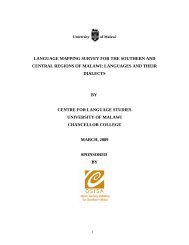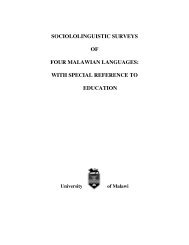languages and area spoken for chitipa - Centre for Language Studies
languages and area spoken for chitipa - Centre for Language Studies
languages and area spoken for chitipa - Centre for Language Studies
Create successful ePaper yourself
Turn your PDF publications into a flip-book with our unique Google optimized e-Paper software.
1.1 INTRODUCTION<br />
The role of language in national development cannot be overemphasized.<br />
Communication is crucial in any development process in that it is concerned with the<br />
transfer of ideas <strong>and</strong> knowledge in ways that enable the recipient to underst<strong>and</strong>, react <strong>and</strong><br />
act upon the in<strong>for</strong>mation received <strong>and</strong> language is central to that communication process.<br />
In Malawi, language as an essential aspect of communication, has not been given the<br />
prominence it deserves in the fight against poverty <strong>and</strong> various other issues of national<br />
development.<br />
Up until the present study was conducted, Malawi did not have up to date <strong>and</strong> reliable<br />
statistics on various linguistic matters in the country. For instance, there were no accurate<br />
statistics on the number of <strong>languages</strong> <strong>spoken</strong> in Malawi <strong>and</strong> their actual geographical<br />
distribution. Available data on Malawi’s linguistic situation was collected by the National<br />
Statistical Office during population censuses. This data was flawed in many ways as the<br />
methods used in collecting the data were not appropriate to language research. The lack<br />
of such important linguistic in<strong>for</strong>mation <strong>for</strong> the country has hampered the <strong>for</strong>mulation of<br />
a comprehensive language policy <strong>for</strong> Malawi. Similarly, the implementation of the local<br />
language education policy <strong>for</strong> primary education (Ministry of Education: Malawi Primary<br />
Curriculum <strong>and</strong> Assessment Procedures Framework, 2004) is being held back by, among<br />
other things, the lack of reliable data on the geographical distribution of Malawian local<br />
<strong>languages</strong>.<br />
In order <strong>for</strong> Malawi to achieve its overall goals of national development as stipulated in<br />
the Malawi Poverty Reduction Strategy Paper (MPRSP), the Vision 2020 <strong>and</strong> The Policy<br />
<strong>and</strong> Investment Framework (PIF), policy makers <strong>and</strong> development planners working on<br />
various issues that have a bearing on language matters need to be guided by reliable<br />
language data.<br />
It is against this background that the <strong>Centre</strong> <strong>for</strong> language <strong>Studies</strong> proposed to conduct the<br />
present study. The investigation was conducted over a period of 30 days from 15 th May –<br />
13 th June 2006, covering all the districts of the Northern region except Likoma Isl<strong>and</strong> due<br />
to problems encountered during the survey (see section 4). Below we present the findings<br />
of the survey in terms of the <strong>languages</strong> <strong>spoken</strong> in the northern region <strong>and</strong> their dialects.<br />
1.2 Objectives<br />
The main objective of the study was to determine the number of <strong>languages</strong> <strong>spoken</strong> in the<br />
northern region, where they are <strong>spoken</strong> <strong>and</strong> number of speakers of these <strong>languages</strong>.<br />
Specific objectives include:<br />
a) To determine the number of <strong>languages</strong>/dialects <strong>spoken</strong> in the northern of<br />
Malawi.<br />
b) To determine the geographical distribution of these <strong>languages</strong>/dialects.<br />
c) To develop an accurate linguistic atlas <strong>for</strong> Malawi<br />
d) To establish the various patterns of language choice <strong>and</strong> use<br />
e) To establish peoples’ language attitudes <strong>and</strong> identities<br />
f) To establish degrees of language loyalty <strong>and</strong> attachment in order to predict<br />
future tendencies towards language shift <strong>and</strong> or maintenance<br />
5





